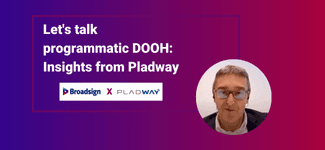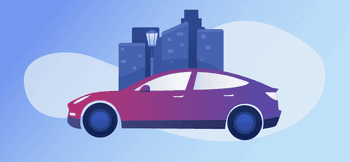In 2018, a group of advertising experts set out to develop a solution that would help bridge the gap between media owners and buyers in the Italian market through programmatic advertising. A first of its kind in the Italian advertising space, the Pladway DOOH platform helped expand programmatic media trading from online to out-of-home advertising.
We spoke with Marco Orlandi, CEO of Pladway to get his insights on programmatic DOOH (pDOOH) trends, omnichannel media strategies, DOOH measurement, and more.
What are some 2022 pDOOH trends to watch based on your observations and requests from brand advertisers?
Programmatic DOOH is recovering at a much faster pace than traditional OOH advertising following the pandemic. The lockdown has digitized us even further, and media owners, brands, and agencies are more receptive to automated ways of working. Media owners are investing in components that offer campaign flexibility and control to buyers while audience targeting is becoming more sophisticated.
Our customer base is also widening, with different types of advertisers wanting to expand into pDOOH. Everyone wants to obtain data for their own campaigns, like mobile retargeting or drive-to-store metrics, so our market shares are increasing and the nature of our customer base is changing. We are no longer only talking to media buying agencies, but also smaller brands and store managers who want to manage campaigns for their stores. These campaigns are more local and simple, with a focus on collecting data to accurately measure effectiveness. In fact, there is a growing demand for data transparency among media buyers, and we also help give visibility into inventory information like audiences, location, and technical specifications.
Buyers are increasingly demanding open deal types, which have traditionally been requested by big agencies and advertisers for reasons like optimizing operating and decision-making processes. However, open deals are now becoming fundamental to other media buyers, like independent or digital agencies, to make media owners’ DOOH inventory more visible and integrable into campaigns. Thanks to open deals, the pDOOH offer is becoming broader and more accessible to small and new agencies, even in digital planning.
Finally, there is more demand for high-quality inventory in the programmatic space. High-quality players with premium inventory locations are entering the space, and in the eyes of media buyers, pDOOH continues to be viewed as a high-value channel.
pDOOH is becoming a powerful part of omnichannel strategies for CPG brands looking to drive demand along the consumer path to purchase. Why do you think this is?
With pDOOH, brands decide on the campaign planning conditions, like scheduling and pacing, and external conditions related to sales systems (like competition or promotion periods). From the DSP perspective, we give brands the tools to refine their strategy as the end client. Brands are looking to DOOH to impact sales, and programmatic is allowing us to speak with them directly versus going through intermediary media agencies.
Brands are also turning towards pDOOH as part of their omnichannel strategies, and we expect to see more and more campaigns and ads based on triggers. Thanks to programmatic, brands can deliver more contextual, sales-related communications by surgically targeting audiences, determining planning conditions, and activating omnichannel campaigns without an intermediary.
Among our recent campaigns, an interesting case point is Suzuki via Changee. The campaign combines pDOOH and mobile retargeting, and also embodies the need for buyers to activate targeted campaigns in retail areas to help drive sales.
What do you think needs to happen at the agency level to ensure DOOH is a staple in every omnichannel media plan?
While there is very clear potential for DOOH and pDOOH to be adopted across agencies, much still needs to happen for this to be realized. This is due to the misalignment between the online and OOH world. As a key player in the programmatic market, our role at Pladway is to educate media buyers and help demonstrate how data can flow between the two mediums. We need to show digital advertisers the value of DOOH, and DOOH specialists need to know that the digital model is one to follow as it opens up the door to new possibilities for increasing campaign effectiveness.
Though OOH and digital advertising are two different channels that are often siloed, they still need to work together to allow agencies to create fully-functioning media plans. All of Pladway’s DSP developments help make it easier for digital planners to access DOOH inventory by providing useful information around locations, facility information, and audience sources. The more data digital planners have at their disposal, the better the link between the two mediums will be.
How important is it for your agency partners to measure the brand impact of their pDOOH campaigns?
Agencies are starting to receive requests from brands to measure brand lift, and these agencies are turning to Pladway for help in measuring how digital advertising and OOH connect. With traditional ad buying, agencies and brands only have partial data regarding campaign performance and execution, and they only have access to these analytics a week or so after the campaign is completed. Programmatic platforms provide insights on real-time campaign performance through mobile ID tracking or geofencing for example, and brands can add their own consumer data to evaluate how the campaign is driving people to store or impacting brand lift.
How would you summarize the key differences between pDOOH and other digital channels?
DOOH communication is typically more effective in terms of visibility and driving emotion compared to purely digital channels. It’s a more transparent and brand-safe medium compared to digital display, however, there are still some technical issues that need to be solved due to its nature as a one-to-many media channel.
What role does Broadsign Reach SSP play in your supply?
To help us expand Pladway’s global footprint, we decided to connect Pladway’s DSP with Broadsign Reach to allow buyers to access new screens from other countries in a quick and easy way. Thanks to the integration, we had the opportunity to expand our offer with locations abroad, and we can now manage media buyers’ requests for global planning of ‘Made in Italy’ brands.
Although we were born as a full-stack solution, having alliances with global players allows us to follow the natural evolution of the programmatic market. By making integration agreements with partners, our customers can continue to expand their businesses and make their own choices in terms of technology and partnerships.
There’s a lot ahead for pDOOH in the next few months. What are you most excited about?
We are excited to continue expanding our customer base, and we plan to add intuitive and visual tools to help us reach small and medium-sized businesses. The goal is to create access to different SSPs while collecting and normalizing data for the market, so we can develop new interface capabilities to run small campaigns that can be accepted by media owners if we focus on automation.
We also need all media owners and buyers to work together on expanding the programmatic market. All platforms need to tell the same story if we want to enlarge the footprint of the market, making it simple to understand, buy, and execute campaigns.






